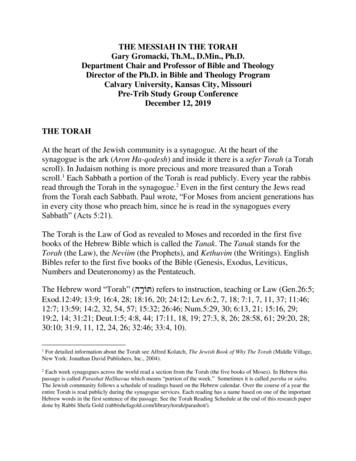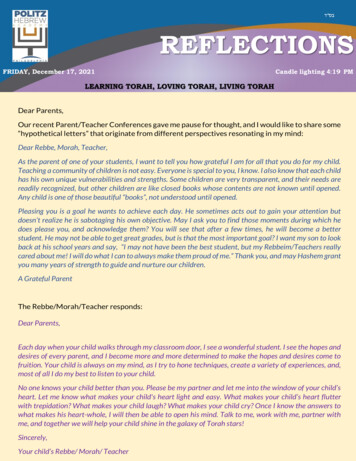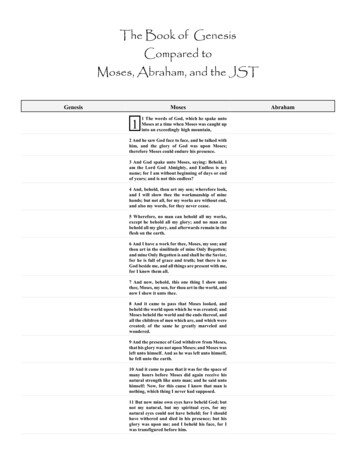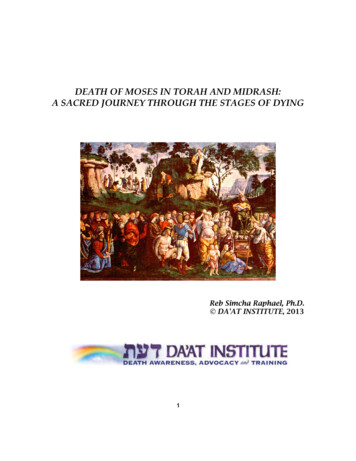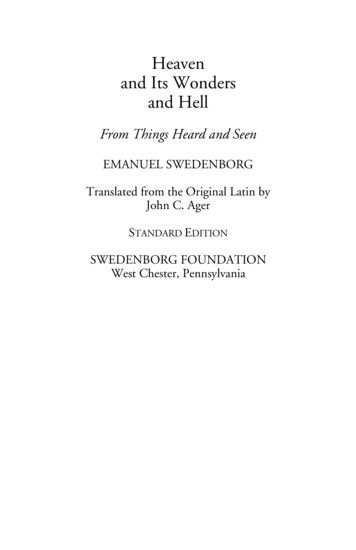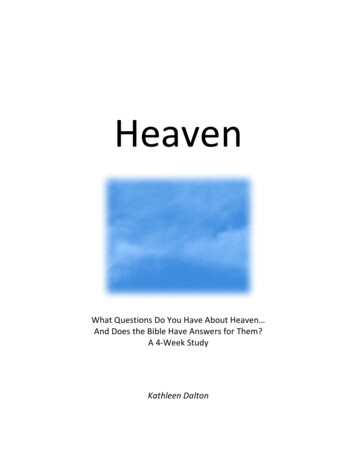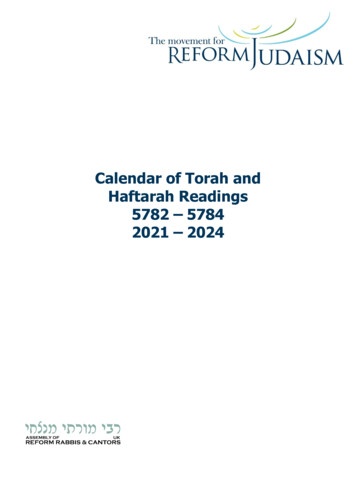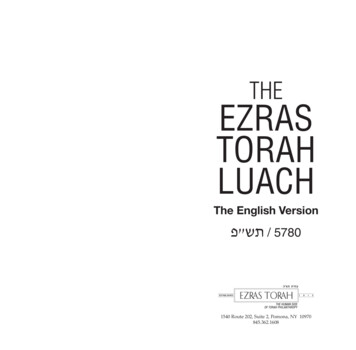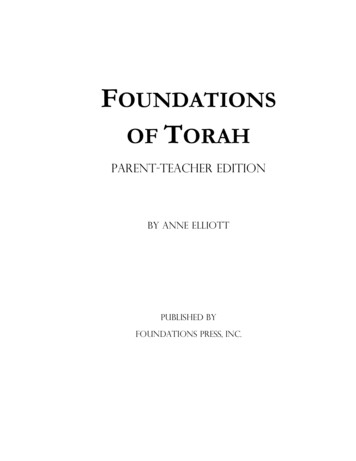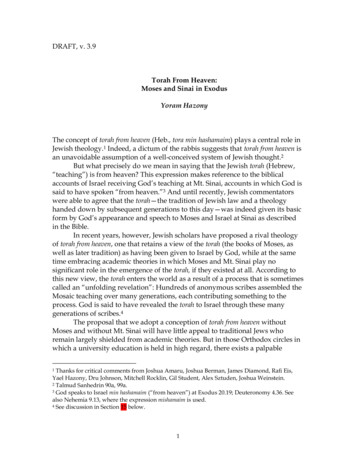
Transcription
DRAFT, v. 3.9Torah From Heaven:Moses and Sinai in ExodusYoram HazonyThe concept of torah from heaven (Heb., tora min hashamaim) plays a central role inJewish theology.1 Indeed, a dictum of the rabbis suggests that torah from heaven isan unavoidable assumption of a well-conceived system of Jewish thought.2But what precisely do we mean in saying that the Jewish torah (Hebrew,“teaching”) is from heaven? This expression makes reference to the biblicalaccounts of Israel receiving God’s teaching at Mt. Sinai, accounts in which God issaid to have spoken “from heaven.”3 And until recently, Jewish commentatorswere able to agree that the torah—the tradition of Jewish law and a theologyhanded down by subsequent generations to this day—was indeed given its basicform by God’s appearance and speech to Moses and Israel at Sinai as describedin the Bible.In recent years, however, Jewish scholars have proposed a rival theologyof torah from heaven, one that retains a view of the torah (the books of Moses, aswell as later tradition) as having been given to Israel by God, while at the sametime embracing academic theories in which Moses and Mt. Sinai play nosignificant role in the emergence of the torah, if they existed at all. According tothis new view, the torah enters the world as a result of a process that is sometimescalled an “unfolding revelation”: Hundreds of anonymous scribes assembled theMosaic teaching over many generations, each contributing something to theprocess. God is said to have revealed the torah to Israel through these manygenerations of scribes.4The proposal that we adopt a conception of torah from heaven withoutMoses and without Mt. Sinai will have little appeal to traditional Jews whoremain largely shielded from academic theories. But in those Orthodox circles inwhich a university education is held in high regard, there exists a palpableThanks for critical comments from Joshua Amaru, Joshua Berman, James Diamond, Rafi Eis,Yael Hazony, Dru Johnson, Mitchell Rocklin, Gil Student, Alex Sztuden, Joshua Weinstein.2 Talmud Sanhedrin 90a, 99a.3 God speaks to Israel min hashamaim (“from heaven”) at Exodus 20.19; Deuteronomy 4.36. Seealso Nehemia 9.13, where the expression mishamaim is used.4 See discussion in Section 15 below.11
temptation to accept the authority of academia on this, as on other matters.Indeed, a Jew who is not well versed in theological matters may well find himselfthinking: Well, what difference does it make? Presumably, an all-powerful Godcould have given the torah to anyone at any time. And as long as the torah isacknowledged to be from God somehow, perhaps we lose little in giving up onMoses and Sinai?My own view is that one cannot give up on Moses and Sinai withoutdevastating Jewish philosophy and theology. This is not only because of issues ofhistoricity—the assumption that a Jewish view of the world must be anchored inthe belief that what is described in the book of Exodus, say, took place in history.The most pressing problem is different: The Bible places Moses and Sinai at thevery center of its teaching concerning God’s nature and his relationship withmankind.5 By suppressing Moses and the events at Sinai, the theory of an“unfolding revelation” overturns the biblical and rabbinic understanding of bothGod and man, offering in their place a description of reality that I believe no Jewand no intelligent person should be willing to accept.In this paper, I make an initial argument in support of this view. Becausethe new theology is principally concerned to show that one can do withoutMoses and the events at Sinai, much of this paper will be devoted to examiningthe significance of Moses and Sinai in the Exodus account of the giving of thetorah. This will involve (i) seeking to establish what are the principal elements ofthe Exodus account of the giving of the torah that require explanation; and (ii)proposing an understanding of what these elements in the Exodus account aremeant to contribute to an overall theology of torah from heaven. Toward the end ofthe paper, I will (iii) return to the question of an “unfolding revelation,”considering some of the differences between this view and a theology of torahfrom heaven based upon the Exodus account.1. Some Preliminary CommentsThis paper is intended to be preliminary and exploratory. I focus on the narrativein the book of Exodus because it is by far the most detailed account of the givingof the torah that we have—and because all later versions are, as far as we know,elaborations upon this text. These considerations make Exodus the place to beginany systematic examination of the principle of torah from heaven, although a fullydeveloped Jewish theology will necessarily have to take into consideration theparallel account in Deuteronomy, as well as the later biblical and rabbinic textsStrauss’ claim that there is no concept of nature in the Bible is, in my view, mistaken, althoughthe biblical understanding of nature is not that of Aristotle. For discussion, see my “The Bible andLeo Strauss,” Perspectives on Political Science (Summer 2016), pp. 190-207.52
that treat this subject. The fact that I do not investigate all of these sources here isto be regarded as reflecting the preliminary nature of this paper, rather than asmaking a positive methodological or ideological statement of some kind.As in my earlier work, I will assume that the biblical text is a form ofinstructional narrative, and that it employs a variety of literary devices (such astype contrasts, recurring language, and metaphor) to broach and discusspositions on philosophical and theological subjects.6For example, the Exodus account of the giving of the torah emphasizesthat Moses had to climb to the top of Mt. Sinai to receive the torah, and that Goddescended from heaven to the top of this same mountain in order to give Israelthe torah. Presumably, God could have spoken to Moses anywhere if he had sochosen. Why, then, is the torah presented as though Moses must ascend to God toget it, and why should God have to descend so that he could reach it?Or consider this: We are informed that the tablets of stone on which theTen Precepts are inscribed were created twice—one set of tablets was producedentirely by God at the top of Mt. Sinai, but these tablets did not survive re-entryinto the world below; whereas a second set did survive the giving of the torah atSinai, but these were carved by Moses out of stone from the base of the mountainand carried up to the top for God to inscribe. What are we to understand fromthe fact that there are two different sets of tablets, and of the dramatic differencesbetween them, both in terms of their provenance and what becomes of them?These and other aspects of the Scriptural account of the giving of the torahraise pressing questions of philosophy and theology. Accepting, as OrthodoxJewish tradition does, that these aspects of the giving of the torah refer to actualevents does nothing to reduce the pressure of the philosophical and theologicalquestions they introduce. Moses climbing Mt. Sinai to receive the torah is no lesscurious an event for having taken place. The fact that Moses’ hands fashioned thesecond set of tablets himself is no less provocative for having happened. We haveto admit that we do not understand the biblical standpoint concerning what itmeans for the torah to be “from heaven” if we do not know what the inclusion ofthese and other elements in the account of the giving of the torah was meant toteach us.I will seek answers to such questions in the manner that I believe the textitself demands: By clarifying the crucial role played in the narrative by the typecontrast between Moses, the elders, and the people; by examining the possiblesignificance of the distinction between the sky (or “heaven”) and the variousplaces where we find human beings standing on the mountain (at the foot of themountain, on the slope of the mountain, and at the summit); and so forth withrespect to other central elements in the story. I do not suppose that myYoram Hazony, The Philosophy of Hebrew Scripture (Cambridge: Cambridge University Press),pp. 66-100.63
interpretations will be correct and complete in every case. Inevitably, somereaders will feel that a given element or complex of elements was meant tocommunicate something other than what I have suggested, and will seek toimprove on my proposals. This is all to the good, of course. But the need foranalysis of this kind in order to approach the meaning of this sophisticated textwill, I hope, be evident.Finally, a comment on the way in which the word torah is used in thispaper. Later Jewish tradition typically uses the word torah to refer to either (a)the five books of Moses, or (b) the entire Jewish tradition, including the Bible andsubsequent rabbinic literature, and so the “giving of the torah at Sinai” is oftenmeant to suggest, in accordance with well-known rabbinic views, that the booksof Moses in their entirety and the entire later tradition were “given” to Moses atSinai.7 Here, I will be examining the Exodus account of Moses and Israel at Sinai,in which the word torah itself appears only with reference to the Ten Preceptsinscribed on the tablets of stone that God gives Moses on the mountain (24.12).*This does not, however, mean that the Ten Precepts exhaust God’s teaching toIsrael at Sinai. Various passages are indicate that God taught Moses a great dealmore during his first forty days on the mountain than what was written on thetablets (31.18, for example; see also Leviticus 25.1). Similarly, the description ofMoses’ second forty days on the mountain provides some of the most importanttheological material in Scripture (32.31-34.29). These and other passagesexamined below make it clear that the “giving of the torah at Sinai” is an event, ora series of events, much more extensive than God’s speaking the Ten Precepts.On the other hand, it is significant that the books of Moses do not describe God’steaching in its entirety as having been given at Sinai. Certain laws are describedas having been given beforehand (e.g., 12.24), whereas others are described ashaving been given in the wilderness after the events at Mt. Sinai (e.g., Numbers36.13). When investigating biblical texts in this paper, I will therefore use theterm torah to refer to everything that is taught to Moses and Israel at Sinaiaccording to the Exodus account. What we can and cannot know about thecontent of this teaching will be discussed below.This is according to the opinion of R. Akiva. R. Ishmael argues that general principles (klalot)were given at Sinai and particular laws (pratot) in the desert. Talmud Sota 37b. The view that allfuture generations of torah were also shown to Moses is expressed by R. Hiya ben Aba in thename of R. Yohanan at Megila 19a.* In this paper, all textual references are to the book of Exodus unless otherwise specified.74
2. The Giving of the Torah: Summary of the Exodus AccountI will begin with a summary of the story of the giving of the torah as it appears inthe book of Exodus. For the sake of brevity, my summary will for omit importantdetails, but many of these will be addressed in the discussion below.According to the book of Exodus, Moses was a son of Israelite slaves whogrew up in Pharaoh’s palace. He flees from Egypt after killing a man who hasabused a slave and takes refuge in the wilderness. (chs. 1-2) God appears to himthere on “the mountain of God,”8 where he speaks to him out of a bush thatburns but is not consumed, instructing Moses to bring Israel up out of Egypt,(chs. 3-4) which he does amid signs and wonders. (chs. 5-15) In accordance withGod’s instructions, Moses then brings the people back to the mountain, whereGod is to appear before them as he appeared before Moses, forging an alliance orcovenant (Hebrew, brit) with them.The giving of the torah at Sinai forms a distinct story within the largernarrative of the exodus from Egypt. Upon first arriving at Mt. Sinai, God sendsMoses to the elders of Israel to determine whether they are willing to enter into acovenant with him. (19.1-9) Having secured their agreement, God then descendsupon the mountain, while Moses brings the people out to the foot of themountain. (19.16-20)9 God then speaks to the people. (20.1-14)10 What he speaksare referred to in the Exodus narrative as aseret hadevarim—an expression usuallytranslated, misleadingly, as the “Ten Commandments,” but which should in factbe rendered the Ten Pronouncements or Precepts. (34.28)11 The people, however,are too frightened to stand at the foot of the mountain and hear the devarim fromGod’s mouth. They back away and demand that Moses speak to them instead ofGod. So Moses speaks God’s words to the people. (20.15-18)12 The peopleThe books of Moses refers to the “mountain of God” (Exodus 3.1, 4.27, 18.5; see also Kings1.19.8) as the “mountain of the Lord” (Numbers 10.33), Mt. Sinai (Exodus 19.11, 18, 20, 23, 31.18,34.2, 32; Leviticus 7.38, 25.1, 26.46, 27.34; Numbers 3.1; see also Nehemia 9.13), and Mt. Horev(Exodus 33.6; Deuteronomy 4.10, 15, 5.2, 9.8, 18.16, 28.89; see also Kings 1.19.8; Psalm 106.19). Iwill use these terms interchangeably.9 Deuteronomy 4.10-11. In this paper, I will often note passages from Deuteronomy that areparallel to those I am discussing in Exodus. Unless otherwise specified, these passages are notedfor ease of reference, and not to advance any specific argument.10 Deuteronomy 5.4, 6-19, 21.11 The expression aseret hadevarim also appears at Deuteronomy 4.13. The term devarim (singular,davar) does not refer to commandments. It means “words” or “things,” and in this context inExodus probably means “things that were spoken.” The convention of referring to these spokenthings as the “Ten Commandments” is entrenched in the English language. Nevertheless, this istroubling since the ten spoken things are only commands or laws in part, and include a numberof statements that are significant as theology or philosophy. I will therefore refer to the “tendevarim” or Ten Precepts.12 Deuteronomy 5.5, 20-25.85
announce their agreement to these precepts, and Moses writes them in a book.(24.3-4)13The next day, Moses builds an altar at the foot of the mountain.14 Hesacrifices to God and reads the “book of the covenant” to the people, who againaccept the alliance or covenant with God. (24.4-8) Moses’ “book of the covenant”obviously includes the Ten Precepts, and may also include additional materialrelevant to the covenant with Israel, although the text is ambiguous on thispoint.15Moses then leads the elders and the priests part of the way up themountain, where we are told that they “looked upon God” and ate a festivemeal. (24.9-11) After a week, Moses climbs from there to the summit of themountain, where he remains for forty days and forty nights. At the summit,Moses receives two tablets of stone, carved and inscribed by God himself, as wellas God’s further teaching so he can impart it to the people. (24.12-18, 31.18)16In Moses’ absence, however, the people have returned to the idolatry theylearned in Egypt.17 They now make a calf of gold and feast and dance before it,declaring “These are your gods, Israel, who brought you up out of the land ofEgypt.” When Moses descends from the mountain and sees that they havebetrayed the covenant, he is enraged and throws down the tablets, smashingthem at the foot of the mountain. Moses summons the Levites, who kill threethousand men and purge the camp of their idolatry. (ch. 32)18There ensues a protracted argument between Moses and God over whatshould be the fate of Israel now. God wishes to destroy Israel and establish a newnation descended from Moses. Moses refuses to cooperate in this, insisting thatGod forgive the people so he may make good on his promise to deliver them totheir land. (32.7-14)19 Seeing that Moses will not be moved, God relents. (32.714)20 He instructs Moses, twice, to take Israel up to their land. (32.34, 33.1-3) ButI am here adopting a chronological reading that places the events of ch. 20 before the events ofch. 24. This is the view of commentators such as Ibn Ezra and Ramban, and strikes me as beingthe simplest and most straightforward reading, allowing God’s command to “Make for me analtar of earth” (20.21) to refer to the altar that will be used thereafter in the covenant ceremony(24.4). (Compare, however, to the interpretation of Rashi, which sees ch. 24 as preliminary to ch.20.)14 The instructions for the making of the altar are given to Moses at Exodus 20.19-23.15 See note 140 below.16 The tablets appear in Deuteronomy 4.13, 5.19, 9.9-11. The broader teaching to Moses isdescribed at Deuteronomy 5.28.17 The Egyptian ways of the people is still being discussed in Joshua 24.14-15; see also Ezekial20.6-9; Exodus Raba 43.7-9.18 Deuteronomy 9.12-17.19 R. Shmuel ben Nahmani, Berachot 32a. R. Abahu goes so far as to say that Moses grabbed holdof God “like a man who seizes his fellow by the garment” in demanding that he pardon Israel.Berachot 32a. See also Exodus Raba 43.120 Deuteronomy 9.18-19, 25-29; 10.10.136
Moses does not accept this either. Understanding that if God does not go withIsrael they will still be threatened with destruction, Moses refuses to break camp.He demands to know God’s ways. God again relents, agreeing to reveal to Moseshis name, (33.12-23)21 and instructs him to carve a second set of tablets, this timefrom the foot of the mountain, and to bring them with him to the summit. (34.13)22Moses carves the second set of tablets and climbs Mt. Sinai, where heagain remains for forty days and nights. (34.4-5) At the summit, God reveals hisname to Moses, in so doing displaying the fact that the world is ultimatelygoverned in justice and mercy. (34.6-7) Upon learning this, Moses again demandsthat God forgive Israel. At this time, God agrees to re-enter the covenant, andinscribes the ten devarim upon the second set of tablets. (34.8-28) Moses thenreturns to the people, his face shining with the light of the knowledge God hasimparted to him. (34.29-35)23Two legal passages interrupt the narrative description of the giving of thetorah, one devoted principally to criminal and civil law (chs. 21-23), and one toinstructions for the construction of the tabernacle and the priestly vestments,along with the inauguration rite of the tabernacle (chs. 25-31.17).24 Afterward, thenarrative describes the construction of the tabernacle, and God’s presenceentering into it as an expression of the restoration of the covenant. (chs. 35-40).3. Moses, the Elders and the PeopleI have presented a summary of the story of Israel at Mt. Sinai as it appears in thebook of Exodus. I want now to go back to the beginning of this story, to thearrival of the Israelites at Sinai, drawing attention to a series of elements thatseem to be playing a metaphorical role within the account of the giving of thetorah.25 My aim will be to isolate these elements, more or less in the order inMoses asks God to reveal to him his name at Exodus 3.13, and receives a certain limitedresponse at 3.14-15. Here, Moses says that God knows him by name (3.12), and then ask to knowGod’s ways (33.13). God agrees that he knows Moses by name (33.17), at which point Mosesinterjects and asks to see his kavod (33.18). God then agrees to proclaim his name before Moses.(33.19).22 Deuteronomy 10.1-2.23 Deuteronomy 10.3-5, 10-11.24 These legal texts apparently represent the instruction Moses receives from God on themountain. However, determining precisely how they relate to the narrative is difficult andsubject to different reasonable interpretations.25 By metaphor I mean any term that is borrowed from its usual semantic field and applied toanother. For example, reference to the people seeing God’s hand upon Egypt in Exodus 14.31, theuse of the term “hand” here is metaphorical because it is not used in its usual way. However, I donot accept the familiar Aristotelian assumption that a metaphoric statement is false. The fact that217
which they appear in the narrative, and to understand what they are intended tocontribute to the construction of the Exodus conception of torah from heaven.As discussed above, the first step in the giving of the torah is God’sapproach to the elders of Israel, which results in their agreement to enter into thecovenant. This is the first of a number of instances in which the narrativedistinguishes the Israelites and their experience at Sinai into three differentcategories or groups: The elders; the people; and Moses himself. In other words,while all of Israel are depicted as having received God’s teaching at Mt. Sinai,this teaching is not received by all of Israel at the same time or in the same way.Let us consider what we know about what each of these three categories orgroups within Israel and what they learn of God’s nature and will at Sinai:(i) The people. As has been said, Moses brings the people to the foot of themountain, (19.17) but when they realize what awaits them there, they back awayout of fear. (20.15, 18) Standing at a distance, they can see only the dark clouds“where God was.” (20.18) Later, however, we are told that the people do seesomething of God, who appears to them “like a devouring fire on top of themountain in the eyes of Israel.” (24.17)26 God attempts to speak to the people asthey stand at the foot of the mountain, speaking the ten devarim to them (20.1-14).But it is not obvious that the people understand anything spoken by God in hisown voice. Rather, God speaks, and the people physically retreat, crying out toMoses: “You speak with us, and we will give heed, but let not God speak withus, lest we die.” (20.16). It appears that the people actually understand little ornothing from God’s speech. What they know of its content is apparently onlywhat Moses speaks to them.27the statement is metaphorical does not mean that God does not have a hand. Rather, it meansthat instead of being like a human hand in all ways, God’s hand is like a human hand only insome ways. Some readers may prefer to substitute analogy for a description of his relation.26 In the account in Deuteronomy, Moses emphasizes that “The Lord spoke to you out of the fire.You heard a voice speaking, but you saw no image in addition to the voice.” Deuteronomy 4.12.See also Deuteronomy 4.15, 33, 36; 5.19; 9.10. In addition, Moses refers to God’s speech as “a voiceout of the darkness” (Deuteronomy 5.20), and the elders refer to it as “a voice out of the fire”(Deut. 5.21, 23). The elders fear that “we will be devoured by this great fire if we continue to hearthe voice of the Lord.” (Deuteronomy 5.22)27 When Moses teaches the people the words of the Ten Precepts, they respond “All the thingsthat the Lord has said we will do” (24.3); and then later “All that the Lord has said we will doand heed.” (24.7) The fact that they do not respond to God’s own speech in this way when theyhear it (20.15-16) strongly suggests that they are too frightened to understand anything, andtherefore too frightened to know the content of God’s commands. This absence of any clearindication that the people in fact hear and understand God’s speech is the source of the viewbrought in the name of R. Yohanan, according to which “when Israel heard the word ‘I’ at Sinai,their souls left them.” Song of Songs Raba 5.16.3. The word “I” is the first word of the firstprecept: “I am the Lord,” so that already at the first word they were overwhelmed and unable tolisten. This is also the view of Maimonides, Guide 2.33, which based especially on the verses “I8
(ii) The Elders.28 Although the people are told only to come to the foot of themountain, the elders and priests of Israel are told to “come up to the Lord andbow down from afar,” and they are in fact able to go part way up the mountain.(24.1-2)29 There, it is said that they “saw the God of Israel, and under his feet akind of paved work of sapphire, like the very heaven for clearness.” (24.10) Thusthe priests and the elders can see God’s legs and his footstool. But as for thecontent of God’s speech, the elders hear and understand no more than the peopledo.(iii) Moses. The elders see God “from afar,” but Moses is able to “draw near” toGod. (20.18, 24.2)30 Unlike the people and the elders, he speaks to God “as a manspeaks to his neighbor.” (33.11)31 He is also able to enter “into the cloud andclimb up the mountain.” Moses is there for forty days and nights, during whichhe is taught the law and receives the first set of tablets. (24.18) After the sin of thestood between the Lord and you at that time to tell you the word of the Lord, for you were afraidbecause of the fire and did not go up to the mountain,”(Deuteronomy 5.5); and “You heard asound of words” (Deuteronomy 4.12), suggesting that the people heard the sound of words butdid not their meaning. Maimonides also points to the verse “that the people may hear when Ispeak with you, and believe you forever” (Exodus 19.9). I would add that Moses is supposed totell the people on God’s behalf that “You have seen that I talked to you from heaven.” (20.19)That is, they “saw” or experienced the fact that God spoke, but there is no indication that theyunderstood his words. Compare Shabbat 88b; Exodus Raba 29.4; Numbers Raba 19.33. A familiaralternative view suggests that the first two commandments, concerning God’s presence and theprohibition on other gods, could be undersood by the people. Makot 24a; Nahmanides on Exodus20.7. According to this view, they would be guilty of violating commands that they had they hadunderstood from God himself in making the gold calf. But it seems to me that the fact that theydid not understand God’s speech to them is precisely the point of the story: The differencebetween God’s speech and the human speech of Moses lies in its ability to reshape the thoughtsof the listener so that a genuine alteration takes place in the understanding. Had the peoplelistened and understood God’s words, this understanding would have reshaped their minds sothat they would not have sinned. They did indeed listen to Moses, but his words did not have thepower to reshape their understanding.28 The expression used to describe the group of the elders and priests together is atzilei bnei israel(24.11) —usually translated as “nobles,” although perhaps “notables” is closer in meaning.29 We are not told that Aharon, Nadav and Avihu have been appointed as priests until a fewpages later, at Exodus 28.1. But we know that the priesthood is already functioning in thepreparations before God speaks the Ten Precepts (19.22, 24), and it seems likely that here, too,Aaron and his sons are intended. In any case, it seems clear that Aaron and his sons are permittedto proceed up the mountain either as the priesthood or as others among the Israelite leadershipwho are shortly to become the priesthood. For simplicity, I refer to them simply as the priests.30 Compare to Moses “drawing near” the camp of the Israelites and learning of the gold calf(32.19). Moses was thus able to see God clearly, as opposed others who saw him dimly. SeeYevamot 49b.31 See also 19.19; Numbers 12.7-8; Deuteronomy 34:10. But compare Genesis 32.31, which againsuggests a certain parallel between Jacob’s struggles with God and those of Moses.9
gold calf, Moses goes back up the mountain for another period of forty days andnights (34.28), during which he receives the second set of tablets. At this time,Moses not only speaks with God, but also sees God pass before him and hears asGod “proclaimed the name of the Lord,” or his essential nature, while Mosesstands in a cleft in the rock at the top of the mountain. (33.20-23, 34.5-7)This three-part distinction appears repeatedly in the account of the giving of thetorah, establishing a type contrast among these three different groups.32 This typecontrast apparently corresponds to three different levels or degrees of knowledgethat are attained by the Israelites, each of which is represented by a differentlocation on Mt. Sinai: Moses, who reaches the summit of the mountain, is able togain a magnificent, although still only partial, view of God’s nature and God’scommands.33 The people, who were supposed to be at the foot of the mountainbut retreat farther away toward the camp, know little or nothing of God’scommands unless Moses explains them to them. And the elders, who do attainsome genuine knowledge of God themselves, occupy an intermediate position onthe slope of the mountain. There, they have their own view of God’s form, whichis to say of God’s nature, and this view is independent of Moses. Although theelders’ view of God’s form is exceedingly limited—all they can see clearly isGod’s feet and his footstool—what they know of God is still much more thanwhat the people can see.34 Regarding the law, however, they are still much likethe people, needing Moses to teach them. When Moses goes up to learn the law,he pointedly tells the elders that they will all have to wait for him there. (24.14)Only Joshua, who will be Moses’ successor, is depicted as being able to go someof the distance with Moses as he climbs further up the mountain. (24.13)354. The Mountain and the SkyWhy is there a mountain in the story of God giving the torah to Israel? I havesuggested that in the Exodus account of the giving of the torah, one’s place on theThe distinction between the message to the Israelites and that to the elders appears already inMoses’ first meeting with God on the mountain. God instructs Moses concerning how he willspeak to the Israelites in Egypt (3.14-15) and also, separately, to the elders (3.16-18). Thanks to JimDiamond for this observation. On type contrasts in biblical narrative, see Yoram Hazony, ThePhilosophy of Hebrew Scripture, pp. 68-74.33 Seforno comments on 33.19-20 that in the proclamation of God’s name, Moses attains a glimpseof his essence. Note, similarly, the dictum of Rav and Shmuel according to which Moses
1 DRAFT, v. 3.9 Torah From Heaven: Moses and Sinai in Exodus Yoram Hazony The concept of torah from heaven (Heb., tora min hashamaim) plays a central role in Jewish theology.1 Indeed, a dictum of the rabbis suggests that torah from heaven is an unavoidable assumption of a well-conceived system of Jewish thought.2 But what precisely do we mean in saying that the Jewish torah (Hebrew,

